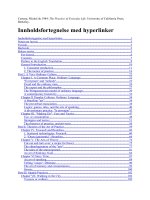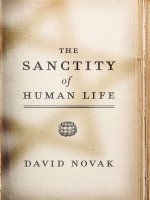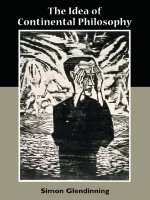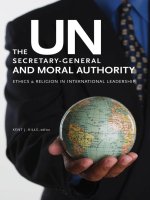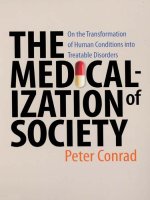georgetown university press the sanctity of human life sep 2007
Bạn đang xem bản rút gọn của tài liệu. Xem và tải ngay bản đầy đủ của tài liệu tại đây (1.27 MB, 203 trang )
The Sanctity
of Human Life
THE SANCTITY
OF
HUMAN LIFE
David Novak
GEORGETOWN UNIVERSITY PRESS
Washington, D.C.
As of January 1, 2007, 13-digit ISBN numbers
have replaced the 10-digit system.
13-digit 10-digit
Cloth: 978-1-58901-176-2 Cloth: 1-58901-176-7
Georgetown University Press, Washington, D.C.
www.press.georgetown.edu
© 2007 by Georgetown University Press. All rights reserved.
No part of this book may be reproduced or utilized in any form or by
any means, electronic or mechanical, including photocopying and
recording, or by any information storage and retrieval system,
without permission in writing from the publisher.
Library of Congress Cataloging-in-Publication Data
Novak, David, 1941–
The sanctity of human life / David Novak.
p. ; cm.
Includes bibliographical references and index.
ISBN-13: 978-1-58901-176-2 (cloth : alk. paper)
ISBN-10: 1-58901-176-7 (cloth : alk. paper)
1. Medical ethics—Religious aspects—Judaism. 2. Embryonic stem
cells—Research—Religious aspects—Judaism. 3. Social medicine—
Religious aspects—Judaism. 4. Assisted suicide—Religious aspects—
Judaism. I. Title.
[DNLM: 1. Judaism. 2. Philosophy, Medical. 3. Ethics, Medical. 4.
Life. 5. Religion and Medicine. W 61 N934 2007]
R725.57.N68 2007
174.2—dc22
2007007013
᭺
ϱ
This book is printed on acid-free paper meeting the requirements
of the American National Standard for Permanence in Paper
for Printed Library Materials.
1413121110090807 98765432
First printing
Printed in the United States of America
To
Batsheva Chaya Stadlan
Hillel Hadar Stadlan
Jordan Ahava Novak
“Children of children are like one’s own children.”
(BABYLONIAN TALMUD:YEVAMOT 62B)
CONTENTS
PREFACE ix
Chapter 1
ON THE USE OF EMBRYONIC STEM CELLS 1
Normative Questions and Normative Contexts 1
Philosophy, Politics, and Theology and Their Interrelations 15
The Status of the Embryo in Current Jewish Discussion 27
Natural Law in Judaism 31
Three Rabbinic Texts Pertaining to Abortion 35
The Embryo before and after the Fortieth Day of Gestation 50
Law and Scientific Evidence 58
The Beginning of Human Life 66
Permission or Obligation? 69
Political Realities 71
Notes 73
Chapter 2
A JEWISH ARGUMENT FOR SOCIALIZED MEDICINE 91
Universal Health Care: Canada and the United States 91
Moral and Theological Problems with the Practice of Medicine 92
Medicine as a Sacred Profession 98
Medicine as a Calling 101
Nonsectarian Medicine 104
Notes 107
Chapter 3
PHYSICIAN-ASSISTED SUICIDE 111
Theology, Philosophy, and Politics 111
Who Is Guilty in Physician-Assisted Suicide? 112
The Physician Kills the Patient 117
The Physician Orders the Patient Killed 118
The Physician Orders the Patient to Commit Suicide 122
The Physician Prepares the Patient for Suicide 127
vii
Suicide as a Reflexive Act 130
Suicide and Personal Responsibility 136
Public Philosophy in a Secular Society 141
Suicide: Public and Private 144
Society’s Claims on the Individual Person 149
Struggling against the Politics of Death 158
Notes 160
BIBLIOGRAPHY 173
INDEX 181
viii
Contents
PREFACE
The term “the sanctity of human life” has a definite religious ring. It
seems to denote the fact that human life is related to God. More-
over, although the term “sanctity of human life” (qedushat ha-
hayyim) does not appear—to my knowledge—in any of the classical
Jewish sources, all the classical Jewish discussions of the life-and-
death questions with which I deal in the three essays here certainly
assume the idea. Does that mean this term can only be used in the-
ological discussions of the normative issues to which this term and
the idea it names pertains? If that is the case, how can the idea of the
sanctity of human life enter philosophical and political discussions
in which not all discussants hold theological assumptions about
God and humans’ relationship with God? Clearly, in the secular
space in which basic questions of public philosophy and policy are
discussed today, one cannot assume any theological consensus, even
among worshipers of the same God, even in the same faith—let
alone among those in different faith communities. So how can one
use a theologically charged idea such as the sanctity of human life in
the absence of any general theological consensus anywhere?
This question leaves a Jewish theologian such as myself, who is
very much concerned with the normative issues I discuss in this
book as they are raised both within my tradition and within the
world at large, with a dilemma. I could confine my discussion of the
sanctity of human life to theological reflection on how it operates
within the normative Jewish tradition—that is, the way it has op-
erated in decisions already made and the way it ought to operate in
decisions now to be made. I would have to find a more secular idea,
however, when I speak as an ethicist or moral philosopher in a sec-
ular context. After all, the normative questions I discuss here—
stem-cell research, universal health care, and physician-assisted
suicide—arise in universities, research laboratories, government bu-
reaus, and hospitals, not in synagogues, yeshivahs, or rabbinical
courts (and not in churches, theological seminaries, or ecclesiastical
ix
courts either, lest it be thought my problem is only a Jewish one).
Therefore, I try to show that the theological meaning of the sanc-
tity of human life in the context of the God–human relationship is
itself related to the idea of the sanctity of human life in the con-
text of interhuman relationships with which philosophical ethics
certainly is concerned. I can do so while working within the Jewish
tradition because there is no issue in the God–human relationship
that does not have a correlate in the interhuman relationship, and
vice versa. Yet I must interrelate theology and philosophy to con-
tend with these three normative questions (or any normative ques-
tions) in a way that does not derive philosophy from theology or
theology from philosophy, or politics from either of them—some-
thing that would ruin all three areas of public discourse and action.
One can see this connection between the theological meaning of
the sanctity of human life and the philosophical meaning of that
term when one distinguishes between theology and philosophy as
follows: Theology deals with the God–human relationship primar-
ily and interhuman relationships secondarily; philosophy, especially
as ethics, deals with interhuman relationships primarily and maxi-
mally can allude to the God–human relationship when it accepts,
minimally, the possibility of that relationship in the world. Politics
adopts both theological and philosophical uses of the sanctity of
human life.
To make this point clearer, consider the use of the Hebrew term
for “sacred” or “holy”—qadosh—first in its original context and then
in terms of how it pertains to human life by analogy. (Some of the
sources on which I draw in making this analogy are II Kings 12:2;
Ezekiel 42:20, 48:15; Mishnah, Meilah 3.6 [and Maimonides, Com-
mentary on the Mishnah thereon], 5.1; Tosefta, Meilah 1.21, 23;
Maimonides, Mishneh Torah: Meilah, 8.1; and Mishnah, Yoma 1.3.)
In the original scriptural sources, qadosh denotes the separation of
something from its ordinary use in the world for the sake of what
lies beyond the world. Most specifically and most often in Scrip-
ture, qadosh pertains to entities—humans or animals or things (qo-
dashim)—that are “holy unto the Lord” (Leviticus 27:32). This
separation has two meanings: one positive, the other negative.
The positive meaning of qadosh pertains to how these sacred en-
tities function as Temple offerings to please God or as articles these
x
Preface
offerings require for their proper preparation as offerings that are
pleasing to God. Thus, they are positively used by the persons who
are charged with preparing them and offering them up to God.
Only those who are personally involved in these ministrations can
possibly experience the sacred relationship positively, however, and
thus understand its essential meaning within the confines of the
Temple itself. In other words, that experience and the understand-
ing of its meaning can come only from the relationship these Tem-
ple ministers have with God, into which these sacred things have
become the means thereto.
The negative meaning of qadosh pertains to how persons outside
the ministrations of the Temple are related to those sacred things.
For them, these sacred things are only inviolable. That is, they are
neither to be harmed in any way nor used for any worldly purpose.
Even worldly use that does not harm these sacred things removes
them from their separation from or transcendence of the world by
making them a commodity of one sort or another. In fact, even out-
siders employed to do work for the Temple—without whose work
the Temple could not be built, be maintained, or function—are
not to be paid from the sacred things themselves but from other
funds, so that the transcendence of the sacred things themselves is
not compromised. Furthermore, even if these outsiders (zarim)
may have heard of how the sacred things function in the Tem-
ple, they must respectfully refrain from violating them. Because
these sacred things are not part of these outsiders’ own personal ex-
perience, however, they cannot very well understand what all this
truly means. As such, they cannot speak about what has no mean-
ing outside the Temple.As Wittgenstein aptly notes,“Of that which
we cannot speak, about that we must be silent” (Tractatus Logico-
Politicus, 7). This is not to suggest, however, that we deny the real-
ity of what we cannot speak by our silence about it in foreign
contexts.
For the ministers of the Temple, who have a positive experience
of the Temple rites and what they intend, the negative can be de-
rived from the positive. That is, because these sacred things play
such an important role in the full cosmic scheme of creation, they
should not be harmed or used for anything other than their essen-
tial function.Yet even persons who are outside this sacred circle can
xi
Preface
understand the negative significance of these sacred things, even if
such outsiders cannot infer the negative from the positive.They can
reach this understanding from their own experience—which is that
these things have always been protected from any violation or ex-
ploitation because they seem to reflect something beyond them-
selves, even if they cannot say what that “something beyond” really
is. Hence, even though they cannot derive the negative—this sense
of respectful restraint—from anything positive in their own expe-
rience, they can sense enough of an allusion to “something beyond”
that they would not reduce these sacred things to their own
worldly use or misuse. For them the sacred is mysterious.
Thus, although the ministers of the Temple and outsiders can
come to the same practical conclusion regarding nonworldly use of
sacred things, they cannot and should not use each other’s logic in
coming to that conclusion.They can only appreciate that use of one
logic in one context does not rule out use of another logic in an-
other context, even when the discourses structured by these re-
spective logics are talking about the same thing.
The analogue to this dichotomy regarding sacred things in the
question of the sanctity of human life is as follows: Religious people
experience the sanctity of human life in their own lives when they
are positively related to God. Jews call that relationship a “cove-
nant” (berit); the constitution of this relationship is the Torah, and it
is acted out by the performance of the commandments (mitsvot).
Realizing that what they experience is a possibility for any human
being, they infer that all human life is inviolable and is not to be ex-
ploited in any way because of that possibility, whether it is realized
or not. These religious people are like the people who minister
within the precincts of the Temple and have tasted the intensity of
what obtains there. They know that the sanctuary and its sacred
things must not be violated or exploited by anyone—that such vio-
lation would contradict the reality they have so intensely experi-
enced and in which they have so actively participated.
Nonreligious people (or religious people whose relationship
with God has no significance for their morally charged relations in
the secular realm) cannot be expected to draw any such inference
because they have no positive basis from which to draw it. Never-
theless, they can appreciate that human life alludes to more than
xii
Preface
merely being a thing in the world that can be destroyed or ex-
ploited. This appreciation often comes out of their experience of
injustice. That is, they cannot accept the reduction of human be-
ings to the status of mere things, which is what injustice assumes.
Even though they cannot or will not offer any positive reasons that
are otherworldly to counter the reductive assumption underlying
all injustice and what is invoked to rationalize it, they refuse to be
persuaded by these rationalizations. Their experience of injustice
has taught them that when these mundane assumptions about the
ordinariness of human life are put into practice, the result is the
degradation of human life to a point of disgust of every human life,
including their own. Human life on these terms is not worth living.
These nonreligious people are like the people outside the Temple
who have not experienced what goes on there yet do not want to
violate or exploit what seems to reflect a reality that is beyond what
can ever be violated or exploited in the world. Moreover, just as
theologians (hakhamim) should instruct persons who participate in
the life of the Temple how and why they are to treat the sacred
things in a way God deserves because of who God is, the philoso-
phers (who also are hakhamim) should instruct persons outside the
Temple how and why to treat human beings in a way they deserve
because of who they are.
Following the analogy to holy things, people who can only pos-
tulate rather than constitute the sanctity of human life are like the
people outside the Temple who have never experienced, let alone
handled, the holy things, yet can still appreciate that (if not yet
why) they are not to be violated or used for any mundane purpose.
In that way, the priests (kohanim) in the Temple could communi-
cate to outsiders (zarim) a message about the inviolability of the
holy things, even though they cannot impose upon these outsiders
their understanding of the positive meaning of these holy things.
After all, these outsiders have never experienced, let alone handled,
what lies within the Temple. There can be no understanding with-
out experience of and with what is to be understood.
Finally, all the theologians need from the philosophers is that the
philosophers not deny the possibility of the revelation from which
the theologians receive their basic norms.All the philosophers need
from the theologians is that the theologians not argue from the
xiii
Preface
authority of revelation and its tradition when they are speaking
outside the sacred precincts of their Temple. When both sides ac-
cept those preconditions, a conversation about the sanctity of
human life is possible at the border between theology and philos-
ophy—a conversation in which the very term “sanctity” can have
multiple yet not mutually exclusive meanings.
That is why I have titled the book comprising these three essays
The Sanctity of Human Life. I hope readers will see that idea as the
unifying feature of these three chapters and agree that this term
can be cogently used in theological, philosophical, and political
contexts. Moreover, as in my previous books, there is a text and a
subtext. In the text I have tried to present arguments that are
meant to be intelligible (perhaps even persuasive) to readers of
general backgrounds and interests. In the longer notes, however, I
try to show how my arguments have been developed out of a wide
variety of textual resources. In fact, I hope that readers with more
specialized interests (in Judaism or secular bodies of knowledge)
will look up some of the sources I cite and discuss in the notes to
check how responsible I have been in my use of these sources, in
addition to how accurate my citation of them has been.
The breakdown of the chapters into their various subsections, as
shown in the table of contents, indicates the subtopics of each of
the chapters and how they are ordered. That breakdown is a better
initial indication of what I am saying than a too-brief summary of
each chapter of the kind one often finds in prefaces of collections
of essays.Therefore, I simply offer a little background to each of the
three essays.
The first chapter, “On the Use of Embryonic Stem Cells,” began
in a paper I delivered at Fordham University Law School in May
2002. I am grateful for comments by persons who were present for
that talk, especially the comments of Professor Suzanne Last Stone
of Cardozo Law School of Yeshiva University, who was the official
respondent to my paper. I also benefited from conversations with
my friend and colleague, Professor Robert George of Princeton
University, who also is the director of the James Madison Program
in American Ideals and Institutions there, of whose Board of Con-
sulting Scholars I am proud to be a founding member. During the
spring semester of 2006, when I was a visiting professor of religion
xiv
Preface
and a William E. Simon Fellow at Princeton, Professor George and
I were able to regularly discuss some of the great moral issues in-
volved in embryonic stem cell research. He helpfully shared with
me his experiences as a member of the commission charged by the
President of the United States with dealing with this question.
The second chapter, “A Jewish Argument for Socialized Medi-
cine,” began as the Isaac Franck Memorial Lecture at the Kennedy
Institute of Ethics at Georgetown University in June 2003. (I was
especially honored to deliver this lecture in memory of Dr. Isaac
Franck, a philosopher who served as the executive director of the
Jewish Federation of Greater Washington in the 1960s, who be-
friended and guided me as a young rabbi and graduate student in
philosophy during that turbulent time.) This essay was subse-
quently published, with minor changes, under the same title in the
Kennedy Institute of Ethics Journal 13 (2003): 313–28. Because of
this article, Dr. Richard Brown, director of Georgetown University
Press, invited me to write this book for the press. I happily accepted
his kind invitation. It was a special privilege to be so invited by the
distinguished press of Georgetown University, which conferred my
Ph.D. in philosophy in May 1971. As a Georgetown alumnus, I very
much appreciate the help of the editorial staff in getting my man-
uscript through the publication process so skillfully.
The third chapter, on “Physician-Assisted Suicide,” began as a
graduate course on that topic that I taught at the University of
Toronto in the spring semester of 1998. I learned a great deal from
the students in that course—especially Dr. Michael Gordon, med-
ical director of the Baycrest Geriatric Centre in Toronto, who took
the course while he was a student in the Joint Centre for Bioethics
of the university (of which I am a faculty member). More recently,
I delivered the Krovonsha Lecture in Bioethics at Loma Linda Uni-
versity in California on this topic. I am grateful to the attentive and
inquisitive audience that attended that lecture. Thanks also are due
to Dr. Mark Carr, now of the faculty of Loma Linda University, who
was my student at the University of Virginia in the early 1990s and
invited me to deliver this lecture. Most recently, I delivered the Dr.
Saul Green Memorial Lecture on this topic at the Faculty of Med-
icine of Dalhousie University in Halifax, Nova Scotia. There too, I
learned much from an attentive and inquisitive audience.
xv
Preface
I have discussed many of the classical Jewish texts represented
and interpreted in this book with my friend, Rabbi Arnold Turin of
Toronto. As always, I have benefited enormously from his learning
and his wisdom (whether we agreed or agreed not to agree on the
meaning of what we have discussed together). I also thank my Uni-
versity of Toronto colleague Timothy Barnes for helping me locate
the classical Greek sources of the modern term “euthanasia.”
Once again, Matthew LaGrone, my Ph.D. student and research
assistant at the University of Toronto, deserves grateful mention. He
was especially helpful in locating important contemporary litera-
ture (in print and on the Internet) that was pertinent to the main
topics of this book. He also offered much good editorial advice and
carefully prepared the index. I want to thank David Stearman for
his superb job of editing, especially some of the philosophical ques-
tions he raised that helped me refine my argument when I was
rewriting some key passages in the body of the text of this book.
Finally, the dedication: When my first grandchild—Zehavya
Stadlan, the firstborn child of my children Marianne Novak and Dr.
Noam Y. Stadlan—was born, I was very proud to dedicate my book
Natural Law in Judaism (Cambridge University Press, 1998) to her.
Now, thank God, there are three more grandchildren: Marianne
and Noam’s daughter Batsheva (born in 1998) and son Hillel (born
in 2001) and Jordan (born in 2003), the daughter of our children
Jacob and Adar Novak. I am now proud to dedicate this book to
these three grandchildren, whose parents are raising them to re-
spect the sanctity of all human life in word and in deed. That legacy
makes my wife and me proud of them and their parents. This ded-
ication is my way of telling others how my wife and I feel about
them (see Zohar 1:233a regarding Genesis 48:20). We truly live
and work for those whom we love.
xvi
Preface
CHAPTER
1
ON THE USE OF EMBRYONIC
STEM CELLS
NORMATIVE QUESTIONS AND NORMATIVE CONTEXTS
The current moral debate about the use of embryonic stem cells
for the possible (some advocates might even say probable) saving
of other human lives is so intense because—as of 2007—deriving
“pluripotent” (useful) stem cells from embryos kills these embryos
in the process. This debate takes place in several different contexts:
scientific, philosophical, political, and theological. Although com-
plete discussion of an issue such as stem cell research must take all
four of these contexts into consideration, one should specify the
particular context of any such discussion.
Because we are dealing with a moral question that arises out of
new scientific research on prenatal life, we should begin our discus-
sion in that context—even though we are approaching this context
of the discussion with our ethical commitments already in hand.
Hence, ethicists on one side of the debate regarding stem cell re-
search use the scientific differentiation of the stages of prenatal life
to bolster their moral differentiation of the stages of prenatal life
by attempting to show that their moral differentiation is not arbi-
trary but has some basis in scientifically established fact. Con-
versely, ethicists on the other side of the debate deny that this
scientific differentiation of the stages of prenatal life has any moral
1
significance and that prenatal life at any stage of its development
deserves protection from harm or extinction. Whereas the first
group of ethicists uses the specific differences in the stages of pre-
natal life to bolster their moral argument, the second group of ethi-
cists uses the genetic commonality of all prenatal life to bolster
their moral argument.Thus, both sides use scientific evidence to es-
cape charges of arbitrariness in dealing with a moral issue that it-
self arises out of scientific research. Nevertheless, although science
lends itself to moral reasoning, especially in issues that affect its
practice, it does not decide what one ought to do with the data and
interpretations of data it has provided. Questions of what one
ought to do are properly discussed in philosophical, theological,
and political contexts.
Scientists distinguish between a zygote or preembryo (an egg
fertilized by a sperm but not yet implanted into the uterine wall,
which usually occurs within ten to fourteen days after fertiliza-
tion), an embryo (an egg fertilized by a sperm that has been im-
planted into the uterine wall), and a fetus (an implanted embryo
after about the eighth week of gestation). Because pluripotent stem
cells are derived from preembryos that have been kept in a petri
dish rather than having been implanted into the uterine wall (as in-
tended in vitro fertilization), in the interest of scientific accuracy
one should speak of stem cells being derived from preembryos. To
be more precise: Such cells come from young embryos, termed
blastocysts, that are only a few days old.
1
Some ethicists—Jewish and non-Jewish alike—use this scientific
differentiation to assert a moral difference between a zygote and an
embryo, arguing that one may treat a preembryo differently from
the way one may treat an embryo. Other ethicists argue that there
is no such moral difference (although there is a theological differ-
ence in certain cases), just as there is no moral difference between
the way one may treat an embryo and the way one may treat a
fetus. The commonality in kind between a zygote and an embryo—
namely, that they both possess the same unique DNA—outweighs
any differences in degree between their respective stages of prena-
tal development. Counting myself among the latter group of ethi-
cists, I use the term “embryo” consistently in discussing stem cell
research, for moral reasons and for greater terminological simplic-
2
On the Use of Embryonic Stem Cells
ity. I reserve use of the term “fetus” in addressing the issue of abor-
tion in the usual sense—namely, extraction of a fetus already in
utero. Embryos that are used for stem cell research, however, are
conceived through in vitro fertilization, which is an extrauterine
procedure.
For both sides in this intense debate over stem cell research using
live embryos, the issue is a matter of life and death. The debate in-
volves three distinct moral questions: May stem cells be derived
from live embryos? Should stem cells be derived from live em-
bryos? Should stem cells not be derived from live embryos?
What may be done is an option that can be done with impunity.
The act is permitted insofar as an applicable norm (legal, moral, or
religious) does not prohibit the act from being done, although there
is no obligation for anyone to actually do it. One cannot infer that
something should be done from mere permission that it may be
done (even though what may be done eventually can become a
low-level obligation either by statute or by custom).
2
What should
not be done and what may not be done have identical normative
meanings, however, inasmuch as they both denote a negative obli-
gation: a “thou shalt not.”
3
Somebody who does what should not be
done is a criminal when the transgressed norm is legal, a reprobate
when the transgressed norm is moral, and a sinner when the trans-
gressed norm is religious. Hence, whether we are speaking in a
legal, moral, or religious context, we must ask whether derivation
of stem cells from live embryos is permitted, obligated, or prohib-
ited. In other words, is it optional, mandatory, or forbidden?
There are three contexts for the discussion of this question: po-
litical, philosophical, and theological. Any public discussion of this
question that does not take all three contexts into consideration,
separately and in correlation with each other, is myopic. Further-
more, the three contexts of this question (and others of similar so-
cial significance) inevitably overlap inasmuch as a Jewish thinker
such as myself has a theological stake in the Jewish tradition,
which can be shown to have philosophical significance on univer-
sal philosophical issues and can be applied in turn to political is-
sues in the particular secular society in which I live. Therefore,
before I can deal adequately with the actual normative question
regarding the use of stem cells from live embryos and the three
3
Normative Questions and Normative Contexts
aforementioned formal normative questions, I must deal with the
three contextual questions at some length. Moreover, this contex-
tual discussion must take place along with the discussion of the
normative question. Hence, this contextual discussion of politics,
philosophy, and theology is interspersed throughout the normative
discussion of the question regarding the use of stem cells from live
embryos. Indeed, politics, philosophy, and theology are inherently
normative disciplines.
By ignoring the need to contextualize the normative discussion,
too many discussions of the issue of stem cell research and similar
issues in bioethics have made very little impact because the persons
to whom they are addressed can say all too frequently, “You are not
talking to us; you are only taking at us. We do not recognize our-
selves to be the persons to whom you are making your moral
claims.” In other words, practical moral claims can be made co-
gently to persons for their response only when the claimant and the
respondent share a common normative domain.
Normative claims made by theologians are especially vulnerable
to the charge of moral irrelevancy. Jewish theologians, especially,
often fall into a pattern of simply declaring “the Jewish point of
view” on some issue or other, without considering why anyone
should act according to what Jewish theologians represent to be a
Jewish norm. Thus, when a Jewish norm is addressed to a non-Jew-
ish audience, that audience can easily reject it by saying (or simply
thinking), “But we are not Jews, nor do we intend to convert to Ju-
daism.” Hence, a broader contextualization of the discussion is
needed to better persuade individuals outside the tradition in
which a particular theology has evolved that its discussion of an
issue such as stem cell research does concern individuals who do
not belong to that tradition—or, for that matter, even persons who
do not belong to any tradition (or any tradition of which they are
aware or admit). That broader contextualization must move into
philosophy. It requires theologians to refine their moral reasoning,
especially when they are required to speak philosophically to
philosophers or even to their fellow citizens who want to hear
philosophical arguments regarding issues of public policy such as
the issue of stem cell research. In other words, in arguing for a par-
ticular normative conclusion—which surely is required of anyone
4
On the Use of Embryonic Stem Cells
who enters the stem cell debate—a Jewish theologian such as my-
self must show that his or her normative conclusion is true and not
just Jewishly correct. Therefore, the discussion here is primarily
philosophical, although I hope it will be consistent with the theo-
logical tradition of rabbinic Judaism. Moreover, the discussion is not
oblivious to what might or might not be prudent politics in deal-
ing with this and similar issues that arise in the public square.
Discussions that reduce this question or any question like it to
the realm of politics or legal technicalities alone ignore the moral
and philosophical questions of why anyone should obey the law of
any polity or why anyone should morally advocate any new public
policies. Reduction of normative questions to the realm of politics
alone also ignores the fact that for most people in our society,
morality is inexplicably bound up with their theology or religious
outlook. That is so whether people are formally religious (in the
sense that they are part of a religious or faith community), infor-
mally religious (an individualist metaphysical mindset that some
people call spirituality), or even antireligious. One might say that
almost all serious people have metaphysical commitments, whether
they are formally religious or not.
One’s outlook is metaphysical when it regards human nature
(that is, one’s humanity or essential humanness) as more than the
mere sum of an individual’s body parts and more than even the col-
lective body politic. (Meta is a Greek prefix that can mean “be-
yond.”) Once we get into what is beyond or transcendent, we
cannot avoid the question of God, whether our answer is pro or
con—which Nietzsche saw better than any other philosopher.
4
Thus, atheists—who think that to affirm human nature is to deny
God—are no less metaphysical than theists who think that to af-
firm human nature is thereby to affirm the human relationship
with God to be its very essence.
5
Metaphysical anthropology re-
fuses to be dismissed as a pseudo-question. We must go beyond
what most modern English-speaking philosophers, let alone most
modern politicians anywhere, have taken to be of any importance.
From here we need to connect metaphysics to ethics.
Metaphysical anthropology deals with what a human being is;
ethics deals with what a human being ought to do. How are they
connected? To recognize whether an act is intentionally human
5
Normative Questions and Normative Contexts
(that is, meant to be humanly done) or not, we must be able to rec-
ognize whether the actor is acting in an appropriately human way
or not: in a way that is worthy or unworthy of a human person as
a metaphysical being—a being whose very presence in the world
points to what is beyond the world. That is what the essential sanc-
tity or inviolability or dignity of human life means.
6
So, is the
choice to do or not to do a particular act truly consistent with the
sacred, inviolable, dignified human nature of the subject of the act,
or not? Is one acting like a human being or like a predatory animal?
Given that ethics governs interpersonal transactions, is the act to be
chosen or resisted consistent with the human nature of the object
of the act or not? Am I respecting the other person before me for
his or her human sanctity, inviolability, and dignity, or not? Am I
treating the other person before me like a predatory animal toward
whom violence is the only appropriate response? In other words, I
am to act because of what I am, and I am to treat others because
of what they are. In the case of my interpersonal transactions, my
own actions and my actions toward whom or with whom I am act-
ing are justified by the exact same reason. That fact alone distin-
guishes intelligent human action from unintelligent behavior—that
is, whether that consciously willed action is justifiable in terms of
its consistency with human nature. The human nature of both the
moral subject and the moral object are expressed in the claims they
make on each other and the choices they themselves make in the
name of what they are and what they need. Human nature, then,
is the true measure of human action.
The twentieth-century Jewish philosopher Martin Buber showed
that human nature is essentially relational, and its essential relation-
ships are all externally constituted.
7
Even internal relations within
the mind (what some philosophers like to call “inner experience”)
are either traces of external relationships from the past or anticipa-
tions of external relationships yet to be. That relational aspect is at
the core of human nature and has ethical implications for those of
us who bear that human nature as its acting subjects and acted-upon
objects. Indeed, no human subject of “I” acts in an ethical vacuum
without intending another human object as a “thou,” and every
human object or “me” discovers his or her humanity when he or she
is addressed by another person as a “thou.”
8
6
On the Use of Embryonic Stem Cells
To act in a dignified human way and to treat other humans with
equal dignity is to affirm the truth of human nature in practice. To
act otherwise and to treat other humans otherwise is to lie, whether
in word or deed. Human nature by its very presence prescribes, as
it were, its own affirmation and proscribes its own denial by both
the human subjects and the human objects who bear it because our
human nature manifests itself primarily in the claims others make
on us and the claims we make on others. Thus, the opposite of the
practical affirmation of the truth of personhood is active lying or
treachery, whereas the opposite of the theoretical affirmation of
the truth of descriptive propositions is only error.
9
Unlike descrip-
tive propositions, persons continually ask us to affirm in word and
deed the truth of their personhood and our own personhood in our
interpersonal transactions with them. Hence, persons ask us to act
truthfully or faithfully with them in a way that descriptive propo-
sitions do not ask us to speak the truth about them. Affirming what
is true of human nature entails an ought: an inherent obligation.
Acting truthfully is being faithful to others and to ourselves along
with them.
Moral objects are unlike the objects we encounter in our techno-
logical, scientific, and aesthetic experience of nature per se. In these
kinds of impersonal experiences, as distinct from interpersonal
transactions, all claims are made by us on the objects before us. Un-
like personal objects, these impersonal objects do not seem to make
any prima facie claims on us (with the possible exception of higher
animals—a point to which I return later). Thus, we claim objects as
useful for us technologically, intelligible scientifically, and beautiful
or enjoyable aesthetically. Only with objects made by persons, such
as oeuvres d’art, do the persons who made these objects make claims
on us through them; that is, these artificial objects bespeak a mes-
sage from their makers for us in one way or another. (Like any prop-
erty, moreover, these artificial objects bespeak the claim of their
owners that I do not harm them or steal them.) Therefore, a meta-
physics of human nature, with its implications for human action,
must be constituted in a fundamentally different way than a meta-
physics of nature per se. (In a metaphysics of creation coming out of
revelation, the commandment of God tells us who created and gov-
erns the nature we experience and how we are to act toward it.That
7
Normative Questions and Normative Contexts
commandment, however, does not come from our experience of na-
ture without this theological mediation.)
10
In addition, whereas a
philosophy of nature per se might be able to avoid the God ques-
tion, a metaphysics of human nature cannot. If a metaphysics of
human nature affirms God, it thereby affirms that human per-
sonhood (comprising intelligence, freedom, and efficacy) is tran-
scended by One who has greater intelligence, freedom, and efficacy.
If a metaphysics of human nature denies God, however, it thereby
affirms that human intelligence, freedom, and efficacy (as distinct
from raw power) transcend everything else in the universe. In one
way or another, an atheistic metaphysics substitutes man for God.
Whether theistic or atheistic, however, no metaphysics of human
nature or philosophical anthropology can avoid the question of
transcendence.
Such metaphysical reflection is an integral feature of an ethics
that distinguishes action from behavior. An authentic human ethics
presupposes a metaphysics of human nature, which Kant saw bet-
ter than any other philosopher when he asserted that the only pos-
sible metaphysics is a metaphysics that is needed for ethics to be
truly rational rather than simply prudential (what Kant called
Metaphysik der Sitten).
11
Hence, the ethical value of an act depends
on how consistent it is with human nature, metaphysically con-
ceived. Moreover, whereas Kant could eliminate the God question
from his metaphysics (or antimetaphysics) of nature per se, he had
to deal with that question of all questions in his metaphysical treat-
ment of morality, although one certainly can challenge the theolog-
ical adequacy of his invocation of God there.
12
Nevertheless, we do not directly derive ethics from metaphysics.
We do not have a metaphysical view of human nature and then put
it into practice. We are already acting in a certain way: doing this
but not doing that, consciously and willfully. When we reflect on
why we are doing this but not that, we see retrospectively that we
act this way because of the way we regard both our own nature and
the nature of those with whom we interact—a nature that is freely
affirmed or denied by the way we act. That reflection is what dis-
tinguishes intentional action from unintentional behavior. A meta-
physically charged ethics, however, is not a theoretical premise
waiting for us to draw a practical conclusion from it. In fact, if we
8
On the Use of Embryonic Stem Cells


